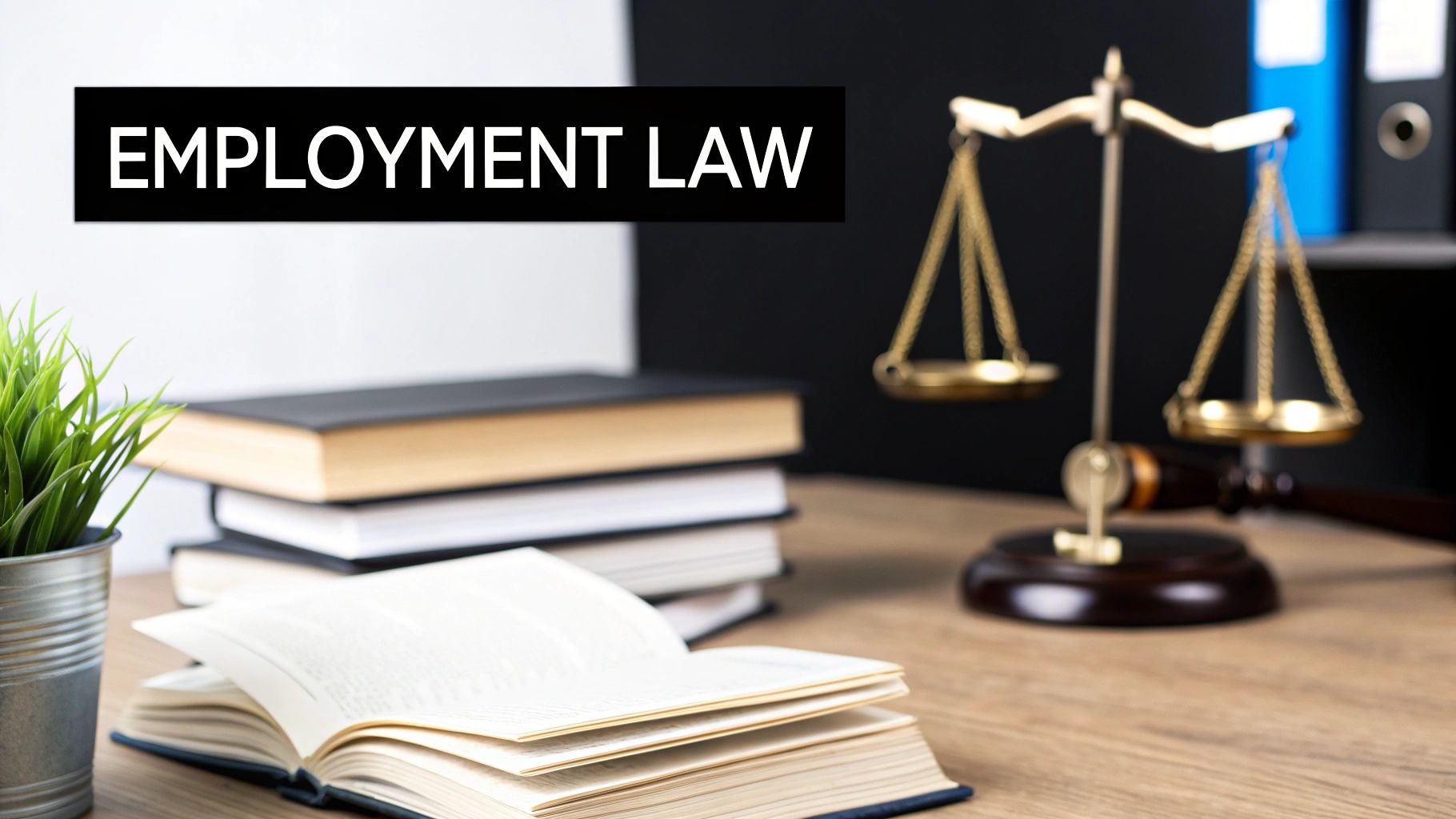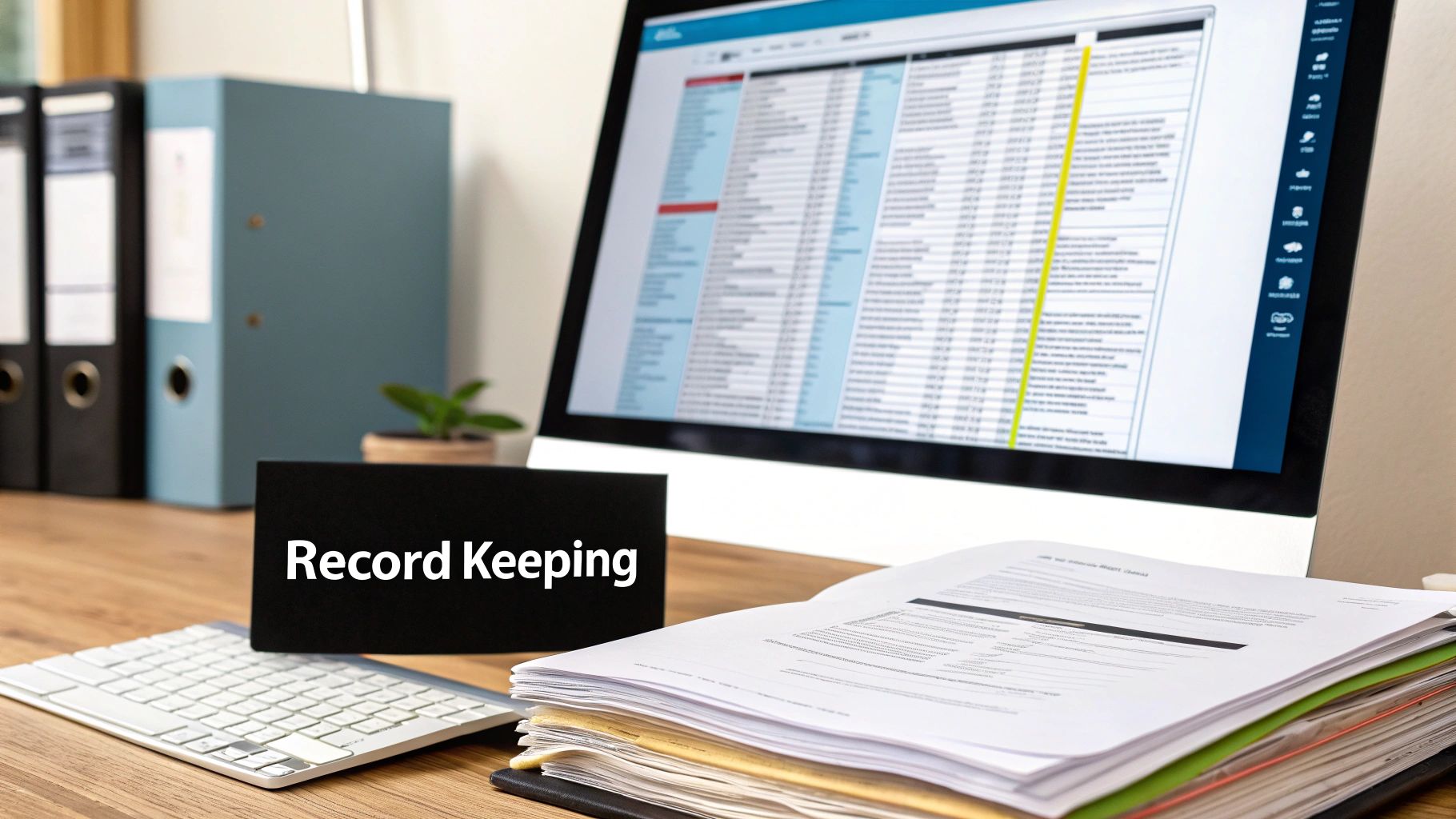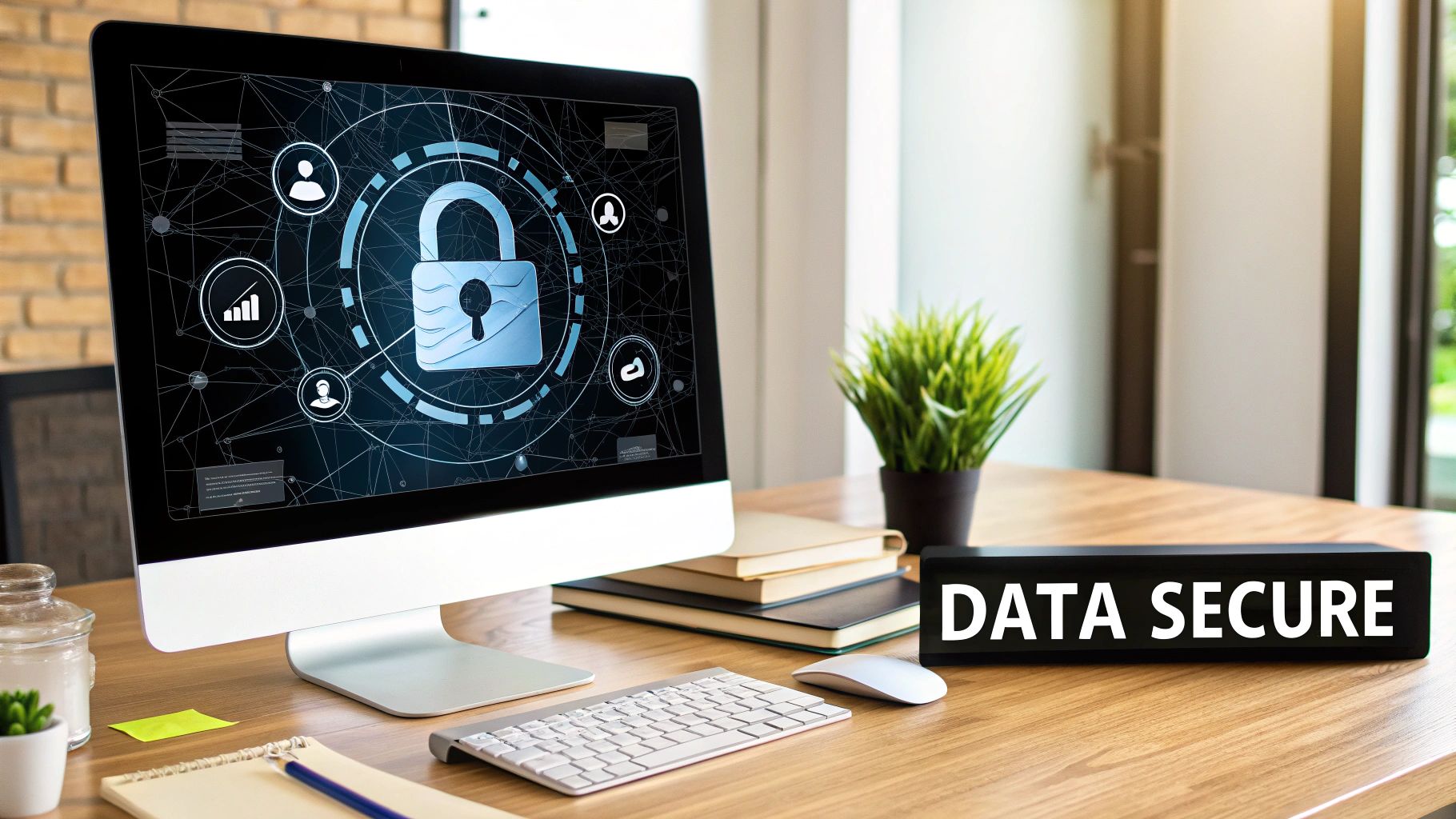Navigating the HR Compliance Landscape in 2025
Staying compliant with HR regulations is critical for building a successful and equitable workplace. This checklist empowers HR professionals of all levels with actionable insights into 10 essential compliance areas for 2025. From employment law and documentation to data protection and training, you'll learn how to mitigate risks and foster a positive work environment. This concise guide provides the knowledge you need to confidently navigate the complexities of HR compliance and build a thriving organization. Let's get started!
1. Employment Law Compliance
Navigating the intricate world of HR requires a strong foundation, and that foundation starts with employment law compliance. This critical aspect of HR ensures your organization adheres to all applicable federal, state, and local employment laws, creating a fair and equitable workplace for everyone. By proactively addressing legal requirements related to hiring, termination, workplace safety, and employee rights, you're not just mitigating legal risks – you're fostering a culture of respect and trust. This proactive approach translates to reduced legal battles, a stronger organizational reputation, and a workforce that feels valued and protected. Embracing employment law compliance isn't merely a checkbox; it's the cornerstone of a thriving, ethical, and legally sound organization.
Employment law compliance encompasses a vast array of regulations, including crucial federal laws like the Fair Labor Standards Act (FLSA), the Family and Medical Leave Act (FMLA), the Americans with Disabilities Act (ADA), Title VII of the Civil Rights Act, and the Age Discrimination in Employment Act (ADEA). Beyond federal mandates, you must also navigate state-specific employment regulations and local ordinances that can significantly impact your HR practices. Keeping up with this ever-evolving legal landscape requires diligent monitoring and regular updates to your policies and procedures.

Think of employment law compliance as a shield, protecting your organization from potential legal pitfalls. Consider Walmart's experience – after facing multiple lawsuits, they implemented comprehensive compliance training to strengthen their HR practices. Similarly, Starbucks proactively developed standardized employment policies adaptable to diverse local regulations, demonstrating a commitment to compliance across their vast network. These examples highlight how prioritizing compliance can transform challenges into opportunities for growth and improvement.
Why is Employment Law Compliance #1 on the HR Checklist?
Simply put, it's the foundation upon which all other HR functions rest. Without a solid understanding and implementation of employment laws, every other aspect of HR is vulnerable. It's the bedrock of fair treatment, employee protection, and a positive work environment.
Features and Benefits of Prioritizing Employment Law Compliance:
- Comprehensive Coverage: Addresses federal, state, and local regulations, ensuring complete legal adherence.
- Proactive Risk Management: Reduces the risk of costly lawsuits and penalties by preventing violations before they occur.
- Ethical Framework: Establishes a clear framework for ethical treatment of employees, fostering a culture of respect and fairness.
- Enhanced Reputation: Builds a strong organizational reputation as a responsible and equitable employer.
Pros and Cons:
Pros:
- Reduced legal risks and penalties
- Ethical and fair treatment of employees
- Positive organizational reputation
Cons:
- Complex and ever-changing regulations
- Requires significant time and resources
- Variations across locations for multi-state employers
Actionable Tips for HR Professionals:
- Stay Informed: Subscribe to legal updates from reputable employment law firms and organizations like SHRM.
- Regular Audits: Conduct quarterly compliance audits to identify and address potential gaps in your practices.
- Legal Counsel: Develop strong relationships with employment attorneys for expert guidance and support.
- Utilize Technology: Leverage compliance software to track changing regulations and streamline your processes.
By prioritizing employment law compliance, you are not only protecting your organization but also empowering your employees and fostering a workplace where everyone can thrive. This proactive approach lays the groundwork for a successful and sustainable HR strategy.
2. Documentation and Record-Keeping
Meticulous documentation and record-keeping isn't just a best practice—it's the bedrock of HR compliance. This crucial function ensures your organization adheres to legal requirements and protects both the company and its employees. By implementing robust systems for storing, protecting, and retaining employee documents, you're building a foundation for a thriving and legally sound workplace. This proactive approach empowers your HR team to navigate audits, disputes, and information requests with confidence and efficiency.
A well-structured documentation process involves several key components: organized personnel files (whether digital or physical), secure storage systems that safeguard sensitive information, clearly defined document retention schedules based on legal mandates, and stringent confidentiality protocols. These elements work together to create a comprehensive system that minimizes risk and maximizes efficiency.

Think of your documentation system as a dynamic resource that supports your HR team in countless ways. Imagine effortlessly retrieving employee information when needed, confidently providing evidence of compliance during audits, and effectively protecting the company during potential disputes or litigation. This is the power of proactive and organized record-keeping. Companies like IBM and Target have championed this approach, with IBM utilizing a digital document management system that automatically flags retention dates and Target implementing standardized personnel file organization across all locations. These examples demonstrate the transformative impact of robust documentation practices.
Why This Matters:
Documentation and record-keeping earns its place on this checklist because it's fundamental to mitigating legal risks and fostering a transparent and organized HR department. It offers numerous advantages:
Pros:
- Proof of Compliance: Provides readily available evidence during audits conducted by agencies like the IRS, DOL, and OSHA.
- Legal Protection: Serves as a critical defense in disputes or litigation, safeguarding the company's interests.
- Efficient Information Retrieval: Enables quick and easy access to employee data when needed for various HR processes.
Cons:
- Storage Costs: Maintaining physical or digital storage systems can incur costs.
- Administrative Burden: Requires dedicated time and resources for organizing and maintaining records.
- Security Requirements: Necessitates robust security measures to protect sensitive employee data.
Actionable Tips for Success:
- Create a Comprehensive Retention Schedule: Develop a schedule based on federal, state, and local regulations to ensure compliance and avoid unnecessary storage of outdated documents.
- Prioritize Security: Implement both physical and digital security measures, such as access controls and encryption, to protect confidential information.
- Regular Audits: Conduct periodic audits of personnel files to ensure accuracy, completeness, and compliance with retention policies.
- Train Your Team: Provide thorough training to HR staff on proper documentation practices, emphasizing accuracy, confidentiality, and legal requirements.
By embracing these best practices, you can transform your HR documentation from a potential liability into a valuable asset, empowering your team to navigate the complexities of compliance with confidence and efficiency. You'll be building a foundation for a legally sound and well-organized HR department, enabling you to focus on strategic initiatives and employee well-being.
3. Hiring and Onboarding Compliance
Hiring and onboarding new talent is an exciting time for any organization. It's the chance to bring fresh perspectives and skills into the fold. But amidst this enthusiasm, it's crucial to remember that a robust and compliant hiring and onboarding process is the bedrock of a thriving and legally sound workplace. This means ensuring every step, from the initial job posting to the completion of new hire paperwork, adheres to all legal requirements. A compliant process not only protects your organization from potential legal issues but also cultivates a fair and equitable environment for all employees, setting the stage for long-term success.
Hiring and onboarding compliance encompasses all aspects of bringing new employees into the organization, ensuring that procedures align with federal, state, and local laws. This includes adhering to non-discrimination practices throughout the hiring process, correctly classifying employees (exempt vs. non-exempt, full-time vs. part-time, etc.), and meticulous completion of all necessary paperwork for new hires. A compliant process typically features legally sound job descriptions and postings, standardized interview questions and processes to reduce bias, adherence to background check compliance regulations, and comprehensive new hire paperwork and verification procedures.
Why is this so vital? Establishing legal compliance from the very start of the employment relationship safeguards your organization from costly legal battles and reputational damage. It creates consistent practices that significantly reduce the risks of discrimination claims, fostering a culture of inclusivity and fairness. Moreover, it sets clear expectations for both the employer and the new employee, laying the groundwork for a positive and productive working relationship.
Reap the Rewards, Navigate the Challenges:
While the benefits are undeniable, implementing a compliant hiring and onboarding process comes with its own set of challenges. It can sometimes slow down hiring processes, requiring meticulous attention to detail. Continuous training of hiring managers is essential to ensure everyone understands and adheres to the latest regulations. Furthermore, navigating the complexities of different requirements across various jurisdictions can be particularly challenging for organizations operating in multiple states or countries.
Turning Best Practices into Actionable Steps:
Consider these practical tips to elevate your hiring and onboarding compliance:
- Create detailed hiring checklists specific to each job category: This ensures that all essential steps are followed consistently.
- Utilize applicant tracking systems (ATS): Many ATS platforms can flag potential compliance issues, streamlining the process and reducing human error.
- Conduct regular audits of I-9 forms and supporting documentation: This proactive approach helps identify and rectify any discrepancies promptly.
- Develop standardized, legally-reviewed interview questions: This promotes fairness and reduces the risk of unconscious bias.
- Ensure job advertisements comply with anti-discrimination laws: Carefully review language and targeting to avoid unintentional exclusion.
Inspired by Industry Leaders:
Companies like Google and Amazon have pioneered innovative approaches to compliant hiring and onboarding. Google's standardized interview process is designed to reduce bias and ensure a fair evaluation of candidates. Amazon's automated onboarding system streamlines the completion of required documents, ensuring efficiency and compliance. These examples demonstrate that robust compliance can be seamlessly integrated with innovative HR practices.
When to Embrace this Approach:
Hiring and onboarding compliance isn't a one-time project; it's an ongoing commitment. It's relevant for organizations of all sizes, from startups to multinational corporations. Whether you're hiring your first employee or your hundredth, adhering to legal requirements is not just a best practice; it's a necessity. Embrace this approach from the outset and cultivate a culture of compliance that will benefit your organization and its employees for years to come. This dedication to fairness and legality is not just a checklist item; it’s a testament to your organization’s values and commitment to building a truly exceptional workplace.
4. Wage and Hour Compliance: The Cornerstone of Fair Labor Practices
Wage and hour compliance isn't just a box to check; it's the foundation upon which a thriving and ethical workplace is built. It's about ensuring your organization adheres to the legal framework governing employee compensation, fostering a culture of fairness and transparency. This encompasses a range of critical areas, from adhering to minimum wage laws and calculating overtime pay accurately, to correctly classifying employees as exempt or non-exempt, managing meal and rest breaks, and meticulously maintaining payroll records. All of these fall under the purview of the Fair Labor Standards Act (FLSA) and often, even more stringent state-specific regulations.
Why is Wage and Hour Compliance Crucial?
This aspect of HR compliance deserves a prominent spot on your checklist because it directly impacts the well-being of your most valuable asset – your employees. By prioritizing wage and hour compliance, you're not just avoiding hefty penalties and legal battles; you're demonstrating a commitment to fair treatment and building trust within your organization. This translates to increased employee morale, higher retention rates, and a stronger employer brand. Furthermore, accurate wage and hour data provides valuable insights into labor costs, enabling more effective budget forecasting and resource allocation.
Key Features of a Robust Wage and Hour Compliance System:
- Time Tracking Systems: Accurate and reliable time tracking is paramount. Modern, automated systems can streamline this process, especially for remote teams, and provide real-time data for payroll processing.
- Overtime Calculation Protocols: Clearly defined protocols based on federal and state laws are essential for accurate overtime calculation, minimizing the risk of underpayment.
- Employee Classification Procedures: Establishing clear procedures for determining exempt vs. non-exempt status is crucial, requiring careful consideration of job duties and responsibilities.
- Meal and Rest Break Policies: Written policies outlining meal and rest break entitlements, ensuring compliance with legal mandates and promoting employee well-being.
- Payroll Record-Keeping: Maintaining meticulous records of employee hours, wages, deductions, and other relevant payroll information is not only a legal requirement but also vital for internal audits and analysis.
Reap the Rewards of Compliance:
The benefits of diligent wage and hour compliance are manifold. It prevents costly lawsuits, which are among the most common employment-related legal actions. Just ask Chipotle, who invested heavily in enhanced time-keeping systems after facing numerous wage and hour lawsuits. It ensures employees are fairly compensated for their time and effort, fostering a positive work environment. And it provides the data-driven insights necessary for effective budget forecasting and labor cost management.
Navigating the Challenges:
While the benefits are clear, wage and hour compliance can be complex. Regulations vary by state, and managing time tracking for remote workers can be challenging. Properly classifying employees as exempt or non-exempt also requires careful attention, as highlighted by Microsoft's experience with contractor reclassification after IRS scrutiny.
Actionable Tips for HR Success:
- Regular Audits: Conduct regular audits of employee classifications to ensure ongoing accuracy and compliance with evolving regulations.
- Automated Time Tracking: Implement automated time-tracking systems with built-in alerts for potential overtime, streamlining payroll and minimizing errors.
- Clear Written Policies: Create clear, accessible written policies on meal breaks and overtime authorization, leaving no room for ambiguity.
- Manager Training: Invest in training for managers on FLSA requirements and state-specific regulations, empowering them to make informed decisions.
- Meticulous Documentation: Document all decisions related to employee classification, providing a clear audit trail and protecting your organization in the event of a dispute.
By embracing these strategies and prioritizing wage and hour compliance, you're not just meeting legal obligations; you're investing in your workforce, fostering a culture of fairness, and building a stronger, more sustainable organization. Remember, the Department of Labor's Wage and Hour Division, state labor departments, and specialized law firms are valuable resources for staying informed and up-to-date on the latest regulations. Embrace these resources, and empower your organization to be a champion of fair labor practices.
5. Benefits Compliance
Navigating the landscape of employee benefits can feel like traversing a complex maze, but with the right approach, it becomes a pathway to a thriving and secure workforce. Benefits compliance, simply put, is about ensuring your organization's employee benefits programs align perfectly with all applicable federal and state regulations. This encompasses everything from healthcare coverage (think ACA, COBRA, and HIPAA) and retirement plan administration (ERISA compliance is key here) to leave policies (FMLA, state-specific family leave laws) and various insurance provisions. Mastering this area not only protects your organization from legal pitfalls but also empowers you to attract and retain top talent with a robust and competitive benefits package.
Why Benefits Compliance Matters:
This isn't just a box to check; it's the bedrock of a healthy employer-employee relationship. By prioritizing benefits compliance, you're demonstrating a commitment to your employees' well-being and ensuring they receive the benefits they are legally entitled to. This builds trust, fosters loyalty, and contributes to a positive work environment. Moreover, it safeguards your organization from potential penalties, legal actions, and reputational damage that can arise from non-compliance.
Features of a Compliant Benefits Program:
- Healthcare Compliance: Navigating the complexities of the Affordable Care Act (ACA), COBRA, and HIPAA is crucial. This includes understanding eligibility requirements, ensuring proper enrollment procedures, and maintaining accurate records.
- Retirement Plan Administration: ERISA compliance is paramount for managing retirement plans. This involves adhering to strict guidelines for plan documentation, fiduciary responsibilities, and reporting requirements.
- Leave Management: Staying abreast of FMLA regulations and any applicable state family leave laws is essential. This requires implementing clear policies and procedures for leave requests, tracking employee eligibility, and ensuring proper documentation.
- Annual Reporting Requirements: Various federal and state agencies require annual reports related to employee benefits. Staying organized and meeting these deadlines is crucial for maintaining compliance.
- Summary Plan Descriptions (SPDs): Providing clear and concise SPDs to employees is a legal requirement and a best practice for transparency.
Real-World Success:
Companies like Comcast and Johnson & Johnson have set the bar high for benefits compliance. Comcast's benefits compliance portal streamlines employee eligibility tracking and enrollment, while Johnson & Johnson's integrated FMLA and disability management system simplifies complex leave administration. These examples demonstrate how technology and strategic planning can transform benefits compliance from a burden into a competitive advantage.
Actionable Tips for HR Professionals:
- Seek Expert Guidance: Partnering with specialized benefits compliance attorneys or consultants can provide invaluable expertise and help you navigate the complexities of the regulatory landscape.
- Leverage Technology: Implementing benefits administration software can automate many tasks, such as tracking eligibility, managing enrollment, and generating required reports.
- Create a Compliance Calendar: Develop a calendar that outlines all required filings, notices, and deadlines to ensure timely compliance.
- Annual SPD Audit: Conduct an annual review of your Summary Plan Descriptions to ensure they are accurate, up-to-date, and compliant with current regulations.
- Invest in Training: Provide comprehensive training to your HR staff on ERISA, ACA, COBRA, and other relevant regulations to empower them to manage benefits effectively.
Pros and Cons:
Pros:
- Ensures employees receive legally required benefits.
- Reduces the risk of penalties and enforcement actions.
- Helps attract and retain talent with competitive, compliant benefits.
Cons:
- High complexity, especially for healthcare regulations.
- Significant administrative burden.
- Can be costly to implement and maintain compliant systems.
Key Influencers:
Key regulatory bodies shaping benefits compliance include the Department of Labor's Employee Benefits Security Administration, the Internal Revenue Service (IRS), and the Department of Health and Human Services (HHS). Staying informed about their latest guidance and updates is crucial for maintaining compliance.
Benefits compliance is not merely a regulatory hurdle; it's an opportunity to build a stronger, more supportive organization. By embracing these best practices and staying informed, you can transform benefits administration into a strategic advantage that empowers your employees and safeguards your organization's future.
6. Health and Safety Compliance
Prioritizing employee wellbeing is not just an ethical imperative, it's a cornerstone of a thriving and productive organization. Health and Safety Compliance, a critical component of any HR checklist, ensures your company fosters a secure and supportive environment where employees can truly flourish. This means implementing robust workplace safety measures and protocols that meet or exceed the standards set by the Occupational Safety and Health Administration (OSHA) and other relevant health regulations. A safe workplace isn't just about avoiding fines; it's about building a culture of care, where every team member feels valued and protected.
How it Works:
Health and Safety Compliance involves a multi-faceted approach, integrating various elements to create a comprehensive safety net for your workforce. This includes:
- Safety Training Programs: Regular, engaging, and job-specific safety training empowers employees to identify and mitigate potential hazards, fostering a proactive safety culture.
- Hazard Communication: Clear and accessible information about hazardous materials, including proper handling and storage procedures, is essential for preventing accidents and protecting employee health.
- Incident Reporting Procedures: A transparent and accessible incident reporting system encourages prompt reporting and allows for swift action to address safety concerns and prevent future occurrences.
- Safety Committee Operations: Establishing a safety committee with employee representation provides a platform for open communication, collaboration, and continuous improvement in safety practices.
- Emergency Preparedness Plans: Comprehensive emergency plans, including evacuation procedures and first aid protocols, ensure a swift and effective response to any unforeseen event, minimizing potential harm.
Inspiring Examples:
Consider the success stories of industry leaders who have championed workplace safety:
- DuPont: DuPont's comprehensive safety management system, developed after a period of high accident rates, became an industry benchmark, demonstrating the transformative power of a dedicated safety program.
- 3M: 3M’s renowned safety training program led to a remarkable 80% reduction in workplace injuries, showcasing the tangible impact of investing in employee safety education.
Actionable Tips for Success:
- Regular Safety Audits and Inspections: Proactive identification of potential hazards through regular audits and inspections helps prevent accidents before they occur.
- Maintain OSHA-Compliant Records: Accurate and up-to-date record-keeping of injuries and illnesses is essential for compliance and provides valuable data for identifying trends and areas for improvement.
- Industry-Specific Protocols: Tailor safety protocols to address the unique hazards present in your specific industry, ensuring comprehensive protection for your workforce.
- Employee-Led Safety Committees: Empower employees by including them in safety committees, fostering a sense of ownership and promoting open communication about safety concerns.
- Anonymous Reporting System: An anonymous reporting system encourages employees to voice concerns without fear of retaliation, facilitating early identification and resolution of potential hazards.
Why Health and Safety Compliance Matters:
Health and Safety Compliance deserves its place on this checklist because it’s integral to building a successful and sustainable organization.
Pros:
- Reduced Workplace Accidents and Injuries: The primary benefit is a demonstrable decrease in workplace accidents and injuries, protecting your most valuable asset – your people.
- Lower Workers' Compensation Costs: Fewer accidents translate directly into lower workers' compensation costs, contributing to the financial health of your organization.
- Improved Employee Morale and Productivity: A safe and supportive work environment boosts employee morale, leading to increased productivity and engagement.
- Demonstrates Commitment to Employee Wellbeing: Prioritizing safety showcases your organization's commitment to employee wellbeing, fostering a culture of trust and respect.
Cons:
- Implementation Costs: Investing in safety equipment and training requires an initial financial outlay, but the long-term benefits far outweigh the costs.
- Administrative Burden: Maintaining documentation and reporting can be administratively demanding, but streamlined systems can minimize this burden.
- Regulatory Complexity: Navigating the complexities of industry-specific regulations can be challenging, but resources and expert guidance are available to support compliance.
By embracing Health and Safety Compliance, you're not just checking a box on a list – you're investing in the wellbeing of your employees, creating a culture of safety, and building a stronger, more resilient organization. It's a win-win for everyone involved. Popularized by organizations such as OSHA, the National Safety Council, and NIOSH, the resources and support you need are readily available to embark on this journey towards a safer and more prosperous future.
7. Anti-Discrimination and Harassment Policies
A truly thriving workplace is one where every individual feels safe, respected, and valued. Building such an environment requires a proactive and unwavering commitment to preventing discrimination and harassment. This is not just a legal obligation; it's a fundamental building block of a positive and productive company culture. That's why robust anti-discrimination and harassment policies are absolutely essential for any HR compliance checklist.
These policies lay the groundwork for a fair and inclusive workplace by clearly defining unacceptable behaviors and outlining the consequences for violations. They work by establishing a framework that empowers employees to speak up against discrimination and harassment, safe in the knowledge that their concerns will be taken seriously and addressed appropriately. A comprehensive policy covers everything from recruitment and promotion to daily interactions and company events. It should address all protected characteristics, including race, color, religion, sex (including pregnancy, sexual orientation, and gender identity), national origin, age, disability, and genetic information, ensuring compliance with Title VII of the Civil Rights Act, the Americans with Disabilities Act, the Age Discrimination in Employment Act, and other relevant legislation.
Features of Effective Policies:
- Written Policies: Clearly written and easily accessible documents outlining prohibited conduct and reporting procedures.
- Regular Training Programs: Mandatory training for all employees on recognizing and preventing discrimination and harassment.
- Reporting Mechanisms: Multiple, confidential avenues for reporting incidents, including online platforms, designated HR personnel, and anonymous hotlines.
- Investigation Procedures: Prompt, impartial, and thorough investigations into all reported incidents.
- Non-Retaliation Provisions: Strong protections against retaliation for individuals who report discrimination or harassment.
Pros:
- Reduced Legal Risk: Minimizes the risk of costly lawsuits and reputational damage.
- Inclusive Culture: Fosters a workplace where diversity is celebrated and everyone feels welcome.
- Improved Employee Morale and Retention: Creates a positive work environment that attracts and retains top talent.
- Demonstrated Commitment to Equality: Shows employees, customers, and the community that your organization values fairness and respect.
Cons:
- Ongoing Effort: Requires continuous monitoring, policy updates, and enforcement.
- Training Costs: Developing and delivering effective training can be time-consuming and expensive.
- Keeping Up with Legislation: Policies must be regularly reviewed and revised to reflect evolving legal requirements.
Examples of Successful Implementation:
- Salesforce: Their equality training program goes beyond legal compliance, incorporating unconscious bias education to foster a more inclusive culture.
- Intel: Intel has developed detailed harassment investigation procedures that ensure fairness and protection for both complainants and the accused.
Actionable Tips:
- Annual Policy Review: Ensure your policies are up-to-date with the latest legal requirements, particularly considering state-specific regulations in locations like California, New York, and Illinois.
- Interactive Training: Engage employees with interactive harassment prevention training that goes beyond passive learning.
- Multiple Reporting Channels: Provide a variety of accessible and confidential reporting mechanisms.
- Manager Training: Equip managers with the skills to handle complaints effectively and sensitively.
- Thorough Documentation: Maintain meticulous records of all investigations and related actions.
Why This Item Deserves Its Place on the List:
Anti-discrimination and harassment policies are not just a checkbox on a compliance list; they are the foundation of a respectful and productive workplace. By prioritizing these policies, you are investing in your employees' well-being, safeguarding your organization's reputation, and building a culture where everyone can thrive. The #MeToo movement and ongoing efforts by organizations like the Equal Employment Opportunity Commission (EEOC) and state fair employment agencies highlight the critical importance of taking a proactive and comprehensive approach to preventing discrimination and harassment. By embracing these principles, you can create a workplace that truly reflects the values of equality and respect.
8. Employee Handbook and Policy Compliance
A well-crafted employee handbook is the cornerstone of a thriving and legally sound workplace. It serves as a central repository of your company's values, expectations, and the guidelines that shape the employee experience. This living document not only clarifies the "rules of the road" but also empowers employees to navigate their roles with confidence and understanding. By establishing clear communication channels and outlining consistent procedures, a comprehensive handbook fosters a culture of transparency, fairness, and mutual respect. This, in turn, reduces the likelihood of misunderstandings, disputes, and potential legal issues, paving the way for a more harmonious and productive work environment.

A robust employee handbook encompasses key features like at-will employment statements (where applicable), a comprehensive code of conduct, clear attendance and leave policies, guidelines on technology and social media use, well-defined disciplinary procedures, and acknowledgment forms. Think of it as a roadmap for both employees and management, ensuring everyone is on the same page and working towards a shared understanding of expectations.
Examples of Success: Companies like Netflix and Zappos have revolutionized the traditional employee handbook. Netflix, for instance, moved away from rigid policies towards a culture document that emphasizes freedom and responsibility. Zappos, known for its vibrant company culture, uses its "culture book" to align policies with its core values, creating a powerful sense of belonging and shared purpose. These examples demonstrate how a handbook can be more than just a rulebook; it can be a powerful tool for shaping company culture and reinforcing values.
Why This Matters: Employee handbook and policy compliance deserves a prominent place on this checklist because it is fundamental to building a legally compliant and positive workplace. It protects both the employer and the employee by setting clear expectations and providing a framework for consistent and fair treatment. Without a well-defined handbook, organizations risk operating in a gray area, leaving them vulnerable to legal challenges and employee dissatisfaction.
Pros:
- Clear Communication: Provides employees with a clear understanding of company expectations, policies, and procedures.
- Consistency: Ensures consistent application of policies across the organization, fostering a sense of fairness.
- Legal Protection: Serves as documented evidence of policy communication in the event of disputes.
- Framework for Fair Treatment: Creates a structure for consistent and equitable treatment of all employees.
Cons:
- Maintenance: Requires regular review and updates to reflect changes in employment laws and regulations.
- Legal Exposure: Poorly written or inconsistently applied policies can create legal risks.
- One-Size-Fits-All Challenges: Generic handbooks may not address the specific needs of all locations or employee groups.
Actionable Tips for HR Professionals:
- Annual Review: Review and update your handbook at least annually to ensure compliance with evolving regulations.
- Legal Counsel Review: Have legal counsel specializing in employment law review your handbook before distribution.
- Flexibility: Avoid overly rigid language that restricts your ability to adapt to changing circumstances.
- Disclaimers: Include disclaimers stating that the handbook is not a contract of employment.
- Signed Acknowledgments: Obtain signed acknowledgments from all employees to confirm receipt and understanding of the handbook.
- Location-Specific Addendums: For multi-state employers, create location-specific addendums to address variations in state laws.
By investing the time and effort to develop and maintain a comprehensive and legally compliant employee handbook, you are not only protecting your organization but also empowering your employees to thrive. This proactive approach sets the stage for a positive, productive, and legally sound work environment where everyone can succeed.
9. Privacy and Data Protection Compliance
In today's digital age, protecting employee data isn't just a best practice—it's a necessity. Privacy and data protection compliance focuses on safeguarding sensitive employee information, including personal details, medical records, and other confidential data, in line with relevant privacy laws. This includes regulations like HIPAA, burgeoning state privacy laws, and emerging international data protection frameworks. This critical aspect of HR compliance builds trust with your employees, minimizes legal risks, and establishes your organization as a responsible steward of information.
Why This Matters:
Imagine the damage—both reputational and financial—that a data breach could inflict on your organization. A robust privacy and data protection program is your first line of defense. It demonstrates your commitment to employee well-being and responsible data handling, fostering a culture of trust and transparency.
Key Features of a Strong Program:
- Data Security Protocols: Implement robust technical safeguards, including encryption, access controls, and regular security assessments, to protect data from unauthorized access.
- Privacy Notices and Policies: Develop clear, concise, and easily accessible privacy policies that inform employees about how their data is collected, used, and protected.
- Access Controls for Sensitive Information: Restrict access to sensitive information based on the "need-to-know" principle. Only authorized personnel should have access to specific data categories.
- Medical Information Segregation: Store medical information separately from other employee data in secure, designated locations, adhering to HIPAA and other relevant regulations.
- Data Breach Response Plans: Prepare a comprehensive data breach response plan that outlines procedures for notification, investigation, and mitigation in the event of a security incident. With the increasing prevalence of remote work and the use of electronic devices in the workplace, it's crucial for businesses to understand the legalities surrounding employee monitoring. For example, consider resources like Ontario's mandatory electronic monitoring policy when developing your own policies.
Pros:
- Enhanced Data Security: Minimizes the risk of data breaches and protects sensitive employee information.
- Increased Employee Trust: Demonstrates a commitment to data privacy, fostering a positive work environment.
- Reduced Legal Liability: Ensures compliance with data protection laws, reducing the risk of fines and legal action.
- Improved Information Management: Establishes a framework for responsible and ethical data handling practices.
Cons:
- Technological Investment: Implementing robust security measures can require significant upfront investment.
- Evolving Regulations: Privacy laws are constantly evolving, requiring ongoing updates to policies and procedures.
- Limited Convenience: Strict access controls can sometimes limit the ease of accessing information.
- International Complexity: Organizations operating internationally face a complex landscape of varying data protection regulations.
Examples of Success:
- Microsoft: Known for its comprehensive data protection program that covers all aspects of employee information handling.
- Apple: Implements a "privacy-by-design" approach to its HR systems, embedding privacy considerations into every stage of development.
Actionable Tips:
- Develop clear and accessible privacy policies specific to employee data.
- Implement need-to-know access controls for all sensitive information.
- Train HR staff on data protection requirements and best practices.
- Conduct regular security audits of HR systems to identify vulnerabilities.
- Store medical information separately in secured files, complying with HIPAA guidelines.
- Create and regularly review data breach response protocols.
- Pay close attention to state-specific requirements, such as CCPA and CPRA in California.
Key Influencers and Enforcers:
The importance of data privacy is underscored by the involvement of organizations like the Department of Health and Human Services (HIPAA enforcement), the Federal Trade Commission (FTC), state attorneys general, and international data protection authorities. Their active role emphasizes the seriousness of these regulations and the need for organizations to prioritize data protection.
10. Training and Development Compliance
Empowering your workforce through comprehensive training and development is not just a good practice; it's a cornerstone of a thriving, compliant, and future-ready organization. This critical aspect of HR compliance ensures your team possesses the knowledge and skills to navigate the complexities of their roles while adhering to legal and ethical standards. It's an investment in your people, protecting your organization and fostering a culture of continuous growth.
Training and development compliance focuses on meeting mandatory training requirements across your organization. This encompasses a wide range of topics, including but not limited to:
- Safety Training: Protecting your employees' physical well-being is paramount. This includes training on hazard identification, safe operating procedures, emergency protocols, and the proper use of equipment.
- Harassment Prevention: Fostering a respectful and inclusive workplace is non-negotiable. Harassment prevention training educates employees on recognizing and reporting harassment, promoting a positive work environment for everyone.
- Ethics Training: Instilling strong ethical principles guides decision-making and builds trust. Ethics training covers topics like conflicts of interest, confidentiality, and responsible conduct.
- Industry-Specific Certifications and Continuing Education: Maintaining professional competence is key to success. This includes ensuring employees hold the necessary certifications and engage in ongoing professional development relevant to their field.
Features of a Robust Training and Development Program:
- Training Tracking Systems: Streamline administration and monitor progress with automated systems.
- Certification Management: Centralize and track employee certifications, ensuring they remain current.
- Mandatory Compliance Courses: Provide readily accessible, engaging content covering all required topics.
- Refresher Training Schedules: Reinforce learning and keep knowledge fresh with regular refresher courses.
- Documentation of Completion: Maintain comprehensive records of all training completed, providing evidence of compliance.
Why Training and Development Compliance Deserves Its Place on the Checklist:
This isn't merely a box to check; it's a vital component of a healthy and successful organization. It mitigates legal risks, reduces workplace incidents, and elevates employee performance.
Pros:
- Ensures Legal and Regulatory Compliance: Protects your organization from penalties and legal action.
- Reduces Liability: Demonstrates due diligence in providing a safe and compliant workplace.
- Improves Employee Skills and Awareness: Equips employees to perform their jobs effectively and safely.
- Creates a Culture of Continuous Learning and Compliance: Fosters a proactive approach to professional development and ethical conduct.
Cons:
- Time Away from Primary Job Duties: Requires dedicated time for training, which can impact productivity in the short term.
- Tracking Completion Across Large Organizations Can Be Challenging: Robust systems are essential for efficient management.
- Mandated Training May Be Viewed Negatively by Some Employees: Engaging content and clear communication about the value of training can address this.
- Content Must Be Regularly Updated: Keeping training materials current with evolving regulations and best practices is crucial.
Examples of Successful Implementation:
- Deloitte: Utilizes a learning management system that automatically assigns compliance training based on employee roles, ensuring targeted and relevant learning experiences.
- Walmart: Employs a systematic approach to safety training across diverse job functions, prioritizing employee well-being in a complex operational environment.
Actionable Tips for Implementation:
- Implement a Learning Management System (LMS): An LMS simplifies tracking, reporting, and administration.
- Create a Role-Based Training Requirements Matrix: Tailor training to specific job functions, ensuring relevance and efficiency.
- Develop Engaging, Scenario-Based Training Content: Increase engagement and knowledge retention with interactive and relatable content.
- Schedule Mandatory Training During Slower Business Periods: Minimize disruption to workflow.
- Maintain Detailed Records of All Completed Training: Ensure you have readily accessible proof of compliance.
- Combine Compliance Training with Professional Development Opportunities: Maximize the value of training by integrating it with career growth initiatives.
Popularized By:
Industry regulatory bodies, Occupational Safety and Health Administration (OSHA), Equal Employment Opportunity Commission (EEOC), and various state agencies requiring specific training have all contributed to the understanding and importance of robust training and development compliance.
By embracing training and development compliance, you're not just meeting requirements; you're investing in a brighter future for your organization and its people. You're cultivating a culture of excellence, driven by knowledge, ethics, and a commitment to continuous improvement.
HR Compliance Checklist: 10-Point Comparison Guide
| Checklist Title | Implementation Complexity (🔄) | Resource Requirements (⚡) | Expected Outcomes (📊) | Ideal Use Cases (💡) | Key Advantages (⭐) |
|---|---|---|---|---|---|
| Employment Law Compliance | High complexity with constantly changing regulations | Significant legal monitoring and update efforts | Reduces legal risks and enhances ethical framework | Multi-state organizations with high litigation exposure | Enhances reputation and minimizes legal penalties |
| Documentation and Record-Keeping | Moderate; requires systematic organization | Needs secure storage systems and regular audits | Provides clear audit trails and legal evidence during disputes | Organizations with extensive employee data management | Strengthens legal protection through organized records |
| Hiring and Onboarding Compliance | Moderate; standardizing practices across jurisdictions | Continuous training and reliable tracking systems needed | Establishes compliant, bias-free hiring and onboarding processes | Companies expanding across diverse regions | Promotes consistency and reduces non-discrimination risks |
| Wage and Hour Compliance | High; involves intricate time tracking and employee classifications | Robust payroll systems and frequent audit protocols required | Ensures fair compensation and minimizes wage-related lawsuits | Businesses with variable work schedules and remote work challenges | Mitigates penalties and improves labor cost management |
| Benefits Compliance | High; complex due to evolving healthcare and related laws | Substantial administrative and technological investments | Guarantees adherence to employee benefit regulations | Large organizations offering comprehensive benefits | Attracts talent and reduces enforcement risks |
| Health and Safety Compliance | Moderate; necessitates regular training and safety audits | Investment in safety equipment and emergency preparedness plans | Reduces workplace injuries and workers' compensation costs | Industries with high-risk or manufacturing environments | Boosts employee morale and operational productivity |
| Anti-Discrimination and Harassment Policies | Moderate; needs consistent updates and recurrent training | Ongoing HR training and active policy enforcement | Fosters an inclusive culture and minimizes legal risks | Diverse workplaces with potential exposure to discrimination claims | Promotes equitable treatment and improved employee retention |
| Employee Handbook and Policy Compliance | Moderate; requires periodic review and legal counsel input | Systematic updates and proper distribution practices | Ensures consistent communication of policies and legal defense in disputes | Companies with multiple locations and varying local requirements | Establishes clear expectations and a robust policy framework |
| Privacy and Data Protection Compliance | High; rapid evolution of data regulations demands constant revisions | Significant technological investments and rigorous audits | Protects sensitive employee data and builds trust | Organizations handling personal and sensitive information | Reduces liability through responsible data management |
| Training and Development Compliance | Moderate; depends on training frequency and content complexity | Dedicated learning management systems and tracking mechanisms | Elevates employee skills while ensuring regulatory adherence | Organizations emphasizing continuous learning and certifications | Enhances compliance culture and minimizes potential liabilities |
Staying Ahead of the HR Compliance Game
Navigating the complexities of HR compliance can feel like a daunting task, but by focusing on the key areas outlined in this checklist—from employment law and documentation to data privacy and training—you can build a robust and resilient HR framework. Mastering these elements isn't just about checking boxes; it's about cultivating a thriving workplace built on respect, fairness, and legal soundness. Prioritizing compliance minimizes risks, fosters employee trust, and ultimately contributes to a more productive and positive organizational culture. Remember, HR compliance is not a destination but a continuous journey of improvement and adaptation. By staying informed, proactive, and committed to best practices, you empower your organization to not just survive, but truly thrive.
Ready to elevate your HR compliance expertise and build a world-class HR function? The Global Human Resource Institute offers comprehensive resources and training to empower HR professionals at all levels. Visit Global Human Resource Institute today to explore our programs and take the next step in your HR compliance journey.




0 Comments